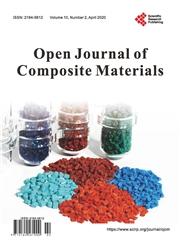Measurement of the In-Plane Thermal Conductivity of Long Fiber Composites by Inverse Analysis
引用次数: 1
Abstract
In the present work, inverse thermal analysis of heat conduction is carried out to estimate the in-plane thermal conductivity of composites. Numerical simulations were performed to determine the optimal configuration of the heating system to ensure a unidirectional heat transfer in the composite sample. Composite plates made of unsaturated polyester resin and unidirectional glass fibers were fabricated by injection to validate the methodology. A heating and cooling cycle is applied at the bottom and top surfaces of the sample. The thermal conductivity can be deduced from transient temperature measurements given by thermocouples positioned at three chosen locations along the fibers direction. The inverse analysis algorithm is initiated by solving the direct problem defined by the one-dimensional transient heat conduction equation using a first estimate of thermal conductivity. The integral in time of the square distance between the measured and predicted values is the criterion minimized in the inverse analysis algorithm. Finally, the evolution of the in-plane composite thermal conductivity can be deduced from the experimental results by the rule of mixture.反分析法测量长纤维复合材料平面内导热系数
在本工作中,对热传导进行了反热分析,以估计复合材料的平面内热导率。进行了数值模拟,以确定加热系统的最佳配置,以确保复合材料样品中的单向传热。通过注射法制备了由不饱和聚酯树脂和单向玻璃纤维制成的复合板,以验证该方法。加热和冷却循环应用于样品的底部和顶部表面。热导率可以从位于沿纤维方向的三个选定位置的热电偶给出的瞬态温度测量值中推导出来。逆分析算法是通过使用热导率的第一估计来求解由一维瞬态热传导方程定义的直接问题来启动的。测量值和预测值之间的平方距离的时间积分是逆分析算法中最小化的标准。最后,根据实验结果,利用混合规律,推导出平面内复合材料导热系数的演化规律。
本文章由计算机程序翻译,如有差异,请以英文原文为准。
求助全文
约1分钟内获得全文
求助全文

 求助内容:
求助内容: 应助结果提醒方式:
应助结果提醒方式:


